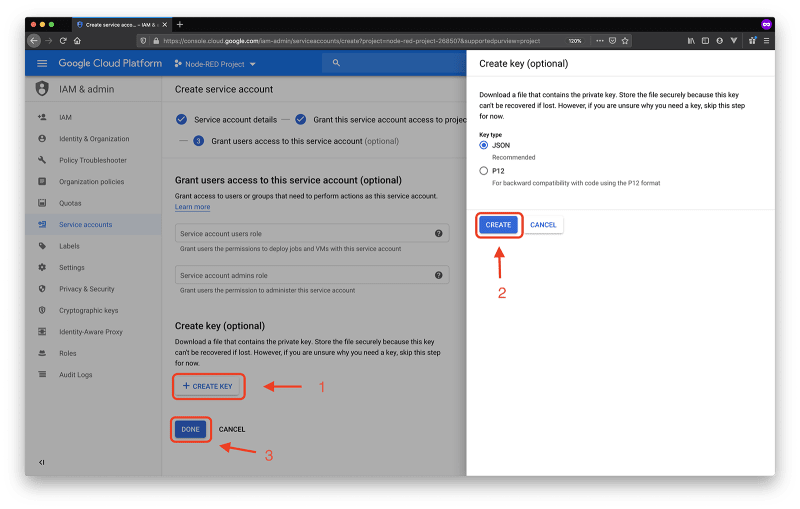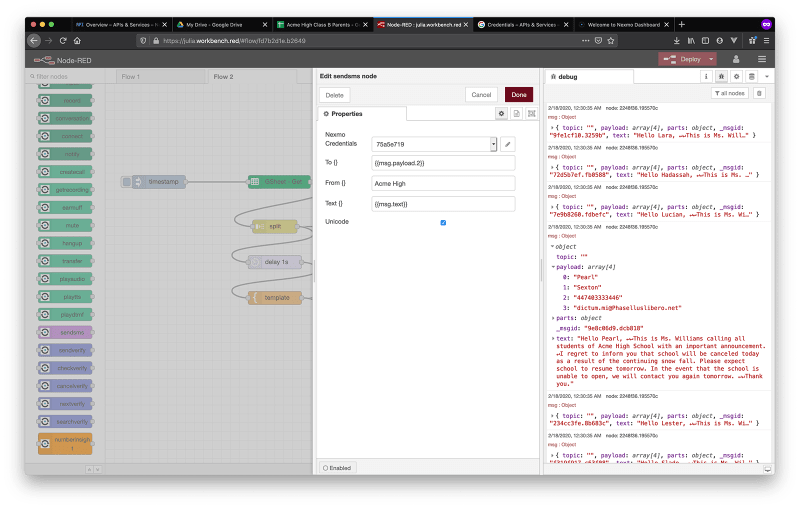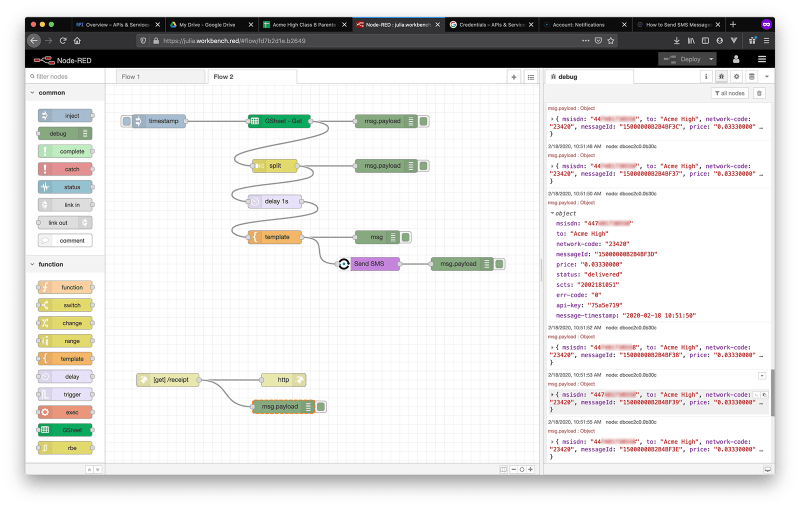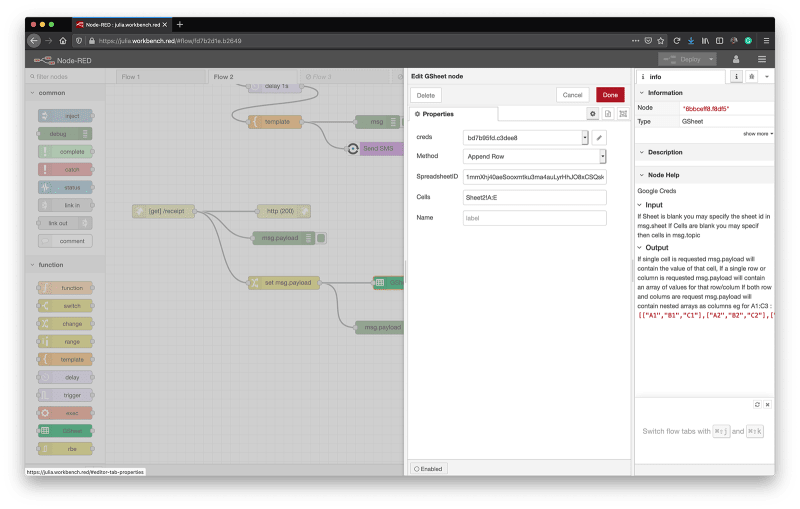Ever got a phone call at 7:59 AM telling you your kid’s school is closed? It was handy, as you were only a couple miles away – on your way home, after dropping them off.
The announcement process in most schools is still manual nowadays, which works in most cases. When something unexpected happens though, like the school is snowed in, a handful of people scramble to call hundreds of parents. You might get the notification in time, or you could be part of the lucky bunch that ended up in the last batch at 7:59.
In this tutorial we’re going to build a Node-RED flow that programmatically sends out notifications to a list of contacts, using Google Sheets and the Nexmo SMS API.
Follow along and pitch it to the principal? Saves you being stuck in traffic on a snow day.
Prerequisites
Before getting started, you’ll need a few things:
- A Node-RED installation, be it a hosted version or on your machine
- A Google account
- A Nexmo account — create one for free if you haven’t already
- A way to expose your server to the internet. This either means you’re running a hosted version of Node-RED or using a tunneling service like ngrok – get up to speed with this Getting Started with Ngrok in Node-RED tutorial
Setting Up Your Editor
Once you open your Node-RED Editor, make sure you have the following packages installed:
To do this, click on the hamburger menu, select Manage Palette. Check for already installed packages under Nodes, and get new ones from the Install tab.
When you’re done, make sure to restart Node-RED and you’re good to go!
Configuring Your Google Account
To interact with the Google Sheets API, you’ll need to use a service account – an identity that an instance can use to run API requests on your behalf. It will be used to identify apps running on your instance to other Google Cloud services.
In this case, your flow that reads a Google Sheet must first authenticate to the Google Sheets API.
You’ll have to create a service account and grant it access to the Google Sheets API. Next, update your app to pass the service account credentials to the Google Sheets API. This way, your flow authenticates seamlessly to the API without embedding any secret keys or user credentials.
Step 1: Create a New Service Account
We’ll start by creating a new project on the Service Accounts Page of the Google Cloud Platform. Click on CREATE to get started.
Next, give your project a name, either select an organization or leave it blank, then press CREATE.
You’ll shortly see a notification pop up that your project has been created.
Now that you have a project, let’s add a service account to it!
Next, you’ll need to create a key that you’ll use to authenticate with the GSheet node in your flow. Click on Create Key, then select JSON as a key type. Save this file when prompted – keep it handy as you’ll need it soon, then hit Done.
Step 2: Enable Google Sheets API for Your Project
From the hamburger menu select APIs and Services -> Dashboard, then click the ENABLE APIS AND SERVICES button. Look for the Google Sheets API in the API Library, open it and click Enable.
Step 3: Sharing Google Sheets with Your Service Account
Go to the Service Accounts page and make a note of the email address associated with the service account you’ve just created. You’ll need to use this email address to share your spreadsheets with the Service Account.
Sending Group Notifications with Google Sheets and Node-RED
Create a Spreadsheet
In case you don’t have a Google Sheet ready, go ahead and create one now.
Google Sheets use a cell-matrix system, where each column can be identified with a letter (starting with A as the first column) and rows are numbered (1 being the first row). In case you’d like to select the second element of the first row, this would be B1.
You can also select ranges of cells by using the TOP_LEFTMOST_CELL:BOTTOM_RIGHTMOST_CELL notation. For example, to select the second and third element of rows 1-5, use B1:C5.
After creating a spreadsheet you’ll see a Sheet1 tab at the bottom of the screen, which is the worksheet you’re currently one. You can rename it or add more worksheets to your spreadsheet.
For this tutorial, I’m using one worksheet with 4 columns: Name, Surname, Phone, and Email – you’ll need at least 2 rows of data to follow along.
Make sure you add a phone number you have access to, so that you can test your flow later on.
Once your spreadsheet is ready, it’s time to share it with your Service Account.
Getting the Data from Your Google Sheet
Start your flow by adding a GSheet node to your workspace. Configure this node to pull in the data from your Google Sheet by filling out the following fields accordingly:
| PARAMETERS | DESCRIPTION |
|---|---|
| Creds | Press the edit button to provide your Service Account key. Remember the JSON file you downloaded earlier? Copy and paste this JSON key in the text field. |
| Method | Select Get Cells from the drop-down menu. This will grab the data from the Google Sheet and pull it into your flow. |
| SpreadsheetID | You can figure out your spreadsheet ID from the URL of your Google Sheet. For example, if the URL is https://docs.google.com/spreadsheets/d/1mmXhj40aeSooxmtku3ma4auLyrHhO8xCSQsklZ1_BU/edit#gid=0, the SpreadsheetID will be the string found in between d/ and /edit: 1mmXhj40aeSooxmtku3ma4auLyrHhO8xCSQsklZ1_BU. Have a look at your spreadsheet URL and find your SpreadSheetID. Then paste this string in the SpreadSheetID field. |
| Cells | Select the cells where your data is located on the spreadsheet. In the example below, this value will be: Sheet1!A2:D30, as the data is found on the worksheet named “Sheet1”, in columns A-D on rows 2-30. Note that we’re not including the table headers. |
Once you’re done editing the GSheet node, press Done.
Next, let’s have a look at the data we’re getting from the Google Sheets API.
Add an inject and a debug node to your workspace and connect them to the GSheet one. Hit Deploy, click on the inject node’s button, then have a look at your debug sidebar.
You’ll notice that the response in msg.payload is an array of arrays, each of these arrays having 4 elements – one line worth of data.
Split the msg.payload Array
This data structure isn’t ideal for further processing, so let’s split the array of arrays into individual arrays.
Fortunately, there is a default node already in your palette that will do the heavy lifting for you.
Find the split node under sequence in your node palette o the left side of your screen. Add it to your workspace, connect it after the GSheet node, follow with a debug , then press Deploy and run your flow again.
Glance over to the debug sidebar and notice the response coming through as a sequence of individual arrays. This way we can process them one at a time, as they are coming in.
Set Delay
In most cases, you wouldn’t want to send out messages at this speed, be it via email, SMS or the channel of your choice.
For example, the Nexmo SMS API has a throughput limit for outbound SMS – all API keys are set with 30 API request per second throughput restriction by default. On top of this, there are also restrictions when sending from certain numbers, so you might be restricted to 1 SMS per second.
To make sure you’re not reaching the throughput limits, it’s a good idea to set a delay on each array coming through msg.payload.
To do this, find the delay node in the function section of your node palette, and connect it after the split node. Double-click on it to open up the node properties and set the delay to 1 second – this should cover most use cases, but feel free to adjust it as needed.
Preparing the Message
At this point, we have all the information we need about the recipients, so let’s move on to the message!
Although you could send the same message to all recipients, it’s always a good idea to make it a little more personal. Getting the bad news is frustrating enough, and a bad user experience won’t make it any better.
Adding a bit of templating won’t only give your message a personal touch, it will also make it appear more professional.
Add a template node after delay. Double-click on it, set Property to msg.text and get creative with your message in the text field!
This text field supports Mustache templating, so you could start with greeting the recipient using their name: {{payload.0}}. This expression references the first element of the msg.payload array, the recipient’s first name.
When you’re done editing, press Done, then Deploy.
Sending SMS Notifications
There are many channels available to deliver your notifications, but in bad weather conditions SMS might be your best bet, so we’ll start with this option.
To send the SMS messages, we’ll use the Nexmo SMS API.
Scroll down to the nexmo section of your node palette and add sendsms to your workspace, connected after the template node.
Set up this node by double-clicking on it and filling in the parameters below. You’ll find API KEY and API SECRET by clicking on the edit button next to Nexmo Credentials.
| KEY | DESCRIPTION |
|---|---|
| API KEY | Your Nexmo API key, shown in your account overview. |
| API SECRET | Your Nexmo API secret, shown in your account overview. |
| TO | The number you are sending the SMS to, {{msg.payload.2}} in this case. |
| FROM | The number or text shown on a handset when it displays your message. You can also set a custom alphanumeric FROM value if this feature is supported in your country. |
| TEXT | The content of your message. Use {{msg.text}} to reference the templated message you’ve created earlier. |
Make sure Unicode is ticked to keep the formatting of your message, then press Done and Deploy.
Run your flow again and see your templated messages appear in the debug sidebar.
Delivery Receipts
When you make a successful request to the SMS API, it returns an array of message objects. Ideally, each of these has a status of 0, indicating that your message has successfully been scheduled for sending. These are the response objects that you’ve just seen in the debug area.
While inspecting this output is quite helpful in determining what the Nexmo SMS API did, there is no guarantee that the message reached the recipient’s handset. Not exactly what you want to hear while sending out snow day alerts, is it?
Once the message reaches its destination, the carrier returns a Delivery Receipt to Nexmo – so don’t panic! All you need to do is set up a webhook endpoint that Nexmo can forward these Delivery Receipts to.
Connect a http input node to a http response node, as well as to a debug node, then fill in the URL field with /receipt in the http input node.
Next, you’ll have to let the Nexmo SMS API know where it should forward the delivery receipts. Go to your API settings in the Default SMS Setting section.
Set the default webhook URL for delivery receipts to YOUR_URL/receipt, then Save changes.
Now you can rest assured that your snow day notifications have indeed reached everyone on your list! Don’t take my word for it though, head over to the debug sidebar and read through your delivery receipts.
Where Next?
Extra Credit: Write Your Delivery Receipts to the Google Sheet
Although the debug sidebar gives you all the insight you’ll ever need, sometimes it’s easier to grasp the result if the data is presented in a more organized fashion.
In this section, we’ll look into writing your delivery receipts back to the same spreadsheet, on a different worksheet(tab).
Pick Your Data
The delivery receipts will contain the following properties of the msg.payload object:
| PROPERTY | DESCRIPTION |
|---|---|
| msisdn | The number the message was sent to. |
| to | Your Nexmo number or the SenderID you’ve set when sending the SMS. |
| network-code | The Mobile Country Code Mobile Network Code (MCCMNC) of the carrier the destination phone number is registered with. |
| messageId | The Nexmo ID for this message. |
| price | The cost of this message. |
| status | Will be one of: delivered, expired, failed, rejected, accepted, buffered or unknown, based on where the message is in the delivery process. |
| scts | When the delivery receipt was received from the carrier in YYMMDDHHMM format. For example, 2001011400 is at 2020-01-01 14:00 |
| err-code | The status of the request. Will be a non 0 value in case of an error. See the Delivery Receipt documentation for more details. |
| api-key | Your Nexmo API key. |
| message-timestamp | The time when Nexmo started to push this Delivery Receipt to your webhook endpoint. |
Decide on which of these parameters matter to you, then using a change node, set msg.payload to an array of the respective properties.
For example, I’m interested in the timestamp, recipient’s number, status, error code and message ID, so I’ll set msg.payload to the following expression:
[payload.`message-timestamp`, payload.msisdn, payload.status, payload.`err-code`, payload.messageId]
Connect this change node into the /receipt webhook, then follow with a GSheet node.
Write Your Data to the Google Sheet
Add another worksheet(tab) to your Google Sheet and make a note of its name – will be “Sheet2” by default.
Next, head back over to your Node-RED editor and open up the GSheet node properties. Select your credentials from the creds drop-down, select Append Row as a Method, fill in your SpreadsheetID, then specify the cell range where you’d like the data to be written. In my case this will be Sheet2!A:E, as I’d like the data to be spread accross columns A-E on worksheet “Sheet2”.
When you’re ready, click Done and Deploy, then run your flow again.
 Congratulations! Your Delivery Receipts have now been logged onto the second worksheet of your spreadsheet. Head over to your Google Sheet and check them out!
Congratulations! Your Delivery Receipts have now been logged onto the second worksheet of your spreadsheet. Head over to your Google Sheet and check them out!
Further Hack Ideas
Tired of having to open up your Node-RED Editor to start your flow? Experiment with different ways to kick it off!
- Try replacing the inject node with an inbound SMS webhook. Send an SMS to your Nexmo number to achieve your task!
- Inbound calls would be another great option! You could even build on it and set up an Interactive Voice Response Menu
- Set up a user interface using the dashboard nodes
Resources
- SMS API Reference
- Getting Started with Ngrok in Node-RED
- Get a better understanding of delivery receipts
- Mustache templating
- JSONata Docs
- JSONata Exerciser
Try Another Tutorial
- How to Build an IVR using Node-RED and the Nexmo APIs
- Build Your Own Voicemail With Node-RED and the Nexmo Voice API
- Forward a Call via a Voice Proxy with Node-RED
- Build a Conference Call with Node-RED
- Verify Phone Numbers with Node-RED
- How to Stream Audio into a Call with Node-RED
- How to Make Text-to-Speech Phone Calls with Node-RED
- How to Receive Phone Calls with Node-RED
- How to Send SMS Messages with Node-RED
- How to Receive SMS Messages with Node-RED






































